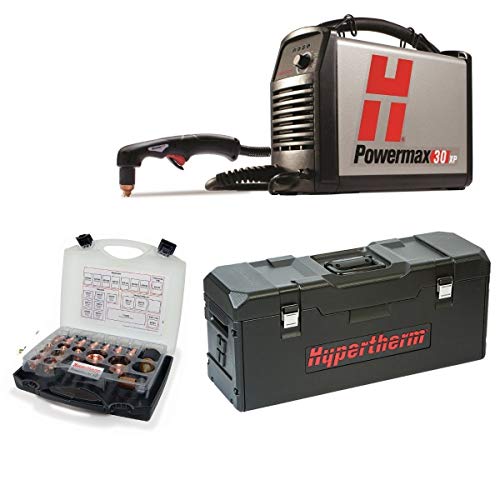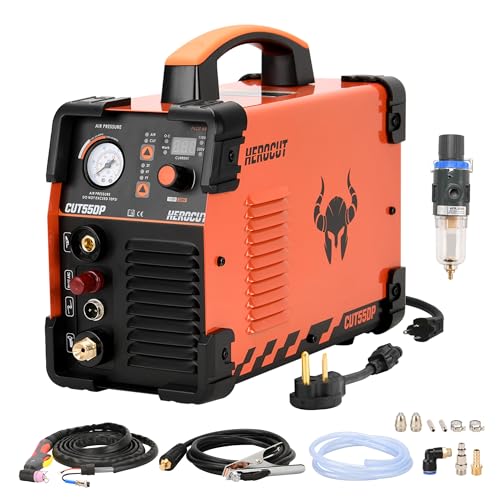Choosing the right plasma cutter can significantly enhance your metal fabrication, automotive repair, or DIY projects. These powerful tools offer a level of precision and speed that traditional cutting methods can’t match, allowing for clean cuts on everything from thin sheet metal to thick plate steel. Whether you’re a professional tradesperson or a serious hobbyist, a quality plasma cutter is an invaluable addition to your workshop.
With numerous models available, selecting the best one involves considering factors like cutting capacity, power requirements, portability, and duty cycle. Our roundup features a selection of top-performing plasma cutters from trusted brands, designed to meet a variety of needs and skill levels. We’ve compiled key details to help you find the ideal machine for your specific metalworking tasks.
The Best Plasma Cutters for Your Workshop
- PrimeWeld 50A Air Inverter Plasma Cutter
- Hypertherm Powermax30 XP Hand Plasma System
- Hobart 500565 Airforce 27i Plasma Cutter
- CUT55DP High Frequency IGBT Inverter Plasma Cutter
- Lotos LTP8000 80 A Plasma Cutter with Pilot ARC
- PRIMEWELD CUT60 60 Amp Dual Voltage Plasma Cutter
- Hypertherm Powermax45 XP Plasma Cutter
- Hobart Airforce 700i 50 Amp Plasma Cutter
PrimeWeld 50A Air Inverter Plasma Cutter

The PrimeWeld CUT50D is a versatile and portable plasma cutting machine designed for users who need flexibility. Its automatic dual-voltage capability (110V/220V AC) means you can use it in a home garage or a professional shop without needing a separate adapter. This unit is built to be both premium and rugged, ready for demanding environments.
It delivers a clean cut on materials up to 1/2 inch thick, making it suitable for a wide range of applications from auto body work to farm equipment repair. The included plasma torch and comprehensive kit provide everything you need to start cutting right out of the box. Its inverter technology ensures a stable arc and efficient performance.
Hypertherm Powermax30 XP Hand Plasma System

Hypertherm is a renowned name in plasma cutting, and the Powermax30 XP lives up to that reputation. This system features auto-voltage technology, automatically adapting to any input power from 110V to 240V, and includes plug adapters for global convenience. It arrives as a complete, ready-to-use kit housed in a durable hard carry case.
You get both standard and Fine Cut consumables, allowing for superior cut quality on thinner materials. The Duramax LT torch is engineered for a comfortable, secure grip and is made from heat and impact-resistant materials for longevity. This system is an excellent choice for metal artists, HVAC technicians, and fabrication shops that require reliability and precision.
Hobart 500565 Airforce 27i Plasma Cutter

The Hobart Airforce 27i is a user-friendly plasma cutter that excels with its Multi-Voltage Plug (MVP), allowing for simple connection to either 120V or 240V power sources. This flexibility makes it a great option for those who may need to move between job sites or use it in different workshop settings. It is particularly effective at cutting 3/8 inch mild steel and can sever up to 5/8 inch.
A notable feature is the Fan-On-Demand cooling system, which operates only when necessary. This reduces the amount of dust and debris pulled into the unit’s interior, promoting a longer lifespan and more consistent performance. It’s a robust and intelligent design from a brand trusted by welders and metalworkers.
CUT55DP High Frequency IGBT Inverter Plasma Cutter

This CUT55DP model is a digital plasma cutter that leverages 55-amp power and IGBT inverter technology for efficient operation. Its high-frequency pilot arc allows for non-touch cutting, meaning you can slice through painted, rusty, or uneven surfaces with ease. The unit is dual voltage, operating on both 110V and 220V, with a maximum clean cut of 12mm on 220V.
Operation is simplified with a clear current display and air gauge fixed on the control panel. It includes useful functions like 2T/4T/PT modes and a post-flow air timer that runs after cutting to cool the consumables, thereby extending their working life. This is a feature-rich machine for its class, offering professional functions at an accessible level.
Lotos LTP8000 80 A Plasma Cutter

For those needing to cut thicker materials, the Lotos LTP8000 offers substantial power with an 80-amp output. It is capable of an ideal cut on 1-inch material and can sever up to 1.5 inches, making it suitable for heavy-duty applications. This unit works on a range of metals, including stainless steel, alloy steel, mild steel, copper, and aluminum.
The non-touch pilot arc torch is highly effective for cutting through rough or contaminated surfaces, producing minimal slag for a cleaner work result. The 2T/4T trigger modes provide flexibility for long cuts, reducing operator fatigue. It’s important to note this unit is designed for 210-250V input and requires a corresponding 60-amp circuit breaker for safe operation.
PRIMEWELD CUT60 60 Amp Dual Voltage Plasma Cutter
Building on the success of their CUT50D model, PrimeWeld’s CUT60 offers increased power with a 60-amp output while retaining the convenient dual-voltage functionality. This step up in amperage provides a greater cutting capacity and improved performance on thicker metals, making it a solid choice for more intensive projects.
The unit is expected to maintain the brand’s reputation for building rugged and reliable equipment that stands up to frequent use. With enhanced power, it remains portable and user-friendly, ideal for both professional metalworkers and advanced DIY enthusiasts who need a machine that can handle a broader range of tasks without compromise.
Hypertherm Powermax45 XP Plasma Cutter
The Hypertherm Powermax45 XP is a professional-grade system designed for high-use environments like fabrication shops, construction sites, and industrial maintenance. It delivers robust cutting power, capable of handling demanding applications and thicker materials with ease, while maintaining the exceptional cut quality Hypertherm is known for.
This system incorporates advanced features such as Auto-Voltage technology and likely includes the durable Duramax torch. It is engineered for maximum productivity and consumable life, reducing operating costs over time. For professionals whose livelihood depends on a dependable and high-performance plasma cutter, the Powermax45 XP is a top-tier contender.
Hobart Airforce 700i 50 Amp Plasma Cutter
The Hobart Airforce 700i represents a step up in the Hobart lineup, offering 50-amp power for enhanced cutting capability. It is designed to provide a reliable and smooth cutting experience for serious hobbyists and professionals alike. The unit is expected to feature Hobart’s user-oriented designs, such as easy-setup controls and a robust build.
With its 50-amp output, this plasma cutter is well-suited for a variety of tasks, from automotive restoration to metal art and fabrication. Hobart’s reputation for creating durable and accessible welding and cutting equipment suggests the 700i will be a dependable and effective tool for anyone needing a balance of power and usability.
Buying Guide: How to Pick the Right Plasma Cutter
Choosing one of the 8 best plasma cutters for metal isn’t just about picking the one with the biggest number on the box. I’ve learned that the right tool depends entirely on what I plan to do with it. The first thing I always look at is the amperage, which directly relates to cutting capacity. A lower-amp machine, around 30 amps, is perfect for auto body work or cutting thin sheet metal. If I need to slice through thicker plate steel, say half an inch or more, I’m looking at a 50-60 amp machine. It’s tempting to buy the most powerful one, but if I only work on thin materials, I’m just paying for electricity and a machine I don’t fully use.
Next, I check the input voltage. This is a big deal for my workshop setup. Many smaller plasma cutters run on standard 120-volt household outlets, which is super convenient for job sites. But the more powerful models require a 240-volt outlet, like what a dryer uses. I had to make sure my garage was wired for it before I even considered a heavier-duty unit. Portability is another key factor for me. If I’m moving around a lot, I look for a machine with a built-in carry handle or even a shoulder strap. Weight matters, too; a compact 40-pound unit is much easier to haul than an 80-pound beast.
I also pay close attention to the duty cycle. This number tells me how long I can continuously cut before the machine needs a break to cool down. A 60% duty cycle at 40 amps means I can cut for 6 minutes straight and then must let it cool for 4 minutes. For my hobby projects, a lower duty cycle is usually fine. But if I’m doing production work, I need a high duty cycle to avoid constant stops. Finally, I consider the consumables—the tips and electrodes that wear out. I check how easy they are to find and how much they cost. Some brands have very affordable and widely available parts, while others can be pricier and harder to track down. Keeping my cutter running smoothly means paying attention to these small, but crucial, components.
FAQ
What safety gear do I need to operate a plasma cutter?
Safety is my number one priority. I never operate my plasma cutter without a proper shaded welding helmet, preferably an auto-darkening one, to protect my eyes from the intense arc. I also wear heavy-duty, flame-resistant gloves and a long-sleeved jacket made of leather or other durable material to protect against sparks and UV radiation. Hearing protection is a good idea, and I always make sure I’m working in a well-ventilated area to avoid inhaling any fumes.
Can I use a plasma cutter on materials other than steel?
Yes, but with some important limitations. My plasma cutter works great on any electrically conductive metal. I regularly use it on stainless steel and aluminum. However, it will not work on non-conductive materials like wood, plastic, or glass. The process relies on completing an electrical circuit with the metal, so without that conductivity, the arc can’t form.
What is the main difference between an inverter and transformer plasma cutter?
For most people like me, an inverter-based machine is the way to go. They are significantly lighter, more portable, and more energy-efficient than the older transformer models. Inverters also provide a smoother cut on thinner metals. Transformer units are heavier and more robust, often used in industrial settings where they might be subjected to rougher treatment, but for my shop and job site needs, the inverter’s portability is a huge advantage.
How do I maintain my plasma cutter to ensure it lasts?
Regular maintenance is simple but essential. After each use, I make sure to clean out any metal dust or debris from the machine’s interior using compressed air. I check the air filter regularly and replace it if it’s dirty, as clean, dry air is critical for the life of the consumables and the torch. I also keep a close eye on the consumable parts—the electrode and nozzle—and replace them as soon as I notice a drop in cutting performance. Storing the unit in a dry place is also key to preventing rust and electrical issues.
Why is clean, dry air so important for a plasma cutter?
The compressed air is a core part of the plasma cutting process; it’s what gets superheated to become the plasma arc. If that air contains moisture or oil, it can contaminate the consumable parts inside the torch, causing them to fail prematurely. Moisture can also lead to a unstable arc and poor cut quality. I use an in-line air dryer/filter between my compressor and the plasma cutter, and I drain my compressor tank frequently to make sure I’m only feeding clean, dry air into one of my 8 best plasma cutters for metal.